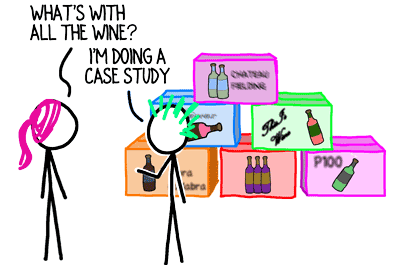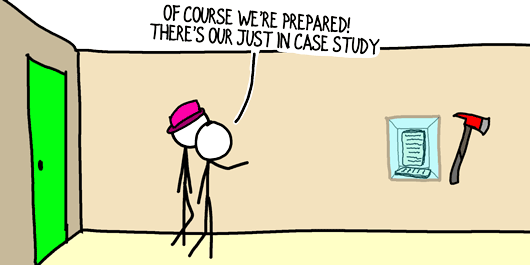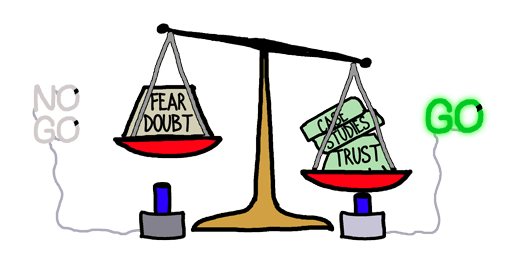Winning business from clients who have previously worked with your consulting firm is relatively easy, because they already trust you.
With new clients, however, you need to establish the belief that you are a credible, reliable source of chocolate a solution to the client’s challenge.
Among the tools to establish trust that you should have in your toolkit is a collection of powerful case studies.

A wavering prospect is torn between their doubt and concerns on the one side and their trust and belief in your consulting firm on the other side. Case studies can thud a heavy weight onto the trust side, tipping your prospect from No-Go to Go.
Well-constructed case studies reinforce your credibility by highlighting your consulting firm’s:
- Depth of experience,
- Depth of knowledge, and
- Track record of success.
If your consulting firm focuses on “soft” issues, the output of your work can feel amorphous, nebulous and intangible. Solid case studies also make the value of your work more concrete.
Case Study Foundation: STAR
Use the well-established STAR framework to anchor your case study.
Situation – In a few words, what problem was your client facing?
Task – What was the desired outcome you were hired to produce?
Action – Summarize (very) briefly the major thrusts of your work. Note, highlight what you did (e.g., rebuilt the organization), not how you did it (e.g., first we interviewed all stakeholders).
Result – Showcase how your client is better off thanks to your work.
Boil your STAR-based project recap down to 100 words or less, and you’ll have an extremely consumable, serviceable case study to solidify trust in your consulting services.
Now it’s time to dress up your case study.

At its most basic, a case study reinforces your firm’s credibility. However, at its most elevated state, your case study will perform similarly to the platinum standard of trust-building: a personal recommendation from a trusted colleague.
All of the elements below will push your case studies up toward that platinum standard.
Case Study Toppings and Add-Ons
Client Logos
Create a more believable, convincing case study by featuring the name of the business you consulted for and, if at all possible, their logo.
Ask for permission, of course.
Decision Maker’s Name
Usually the individual who hired you doesn’t hold celebrity status in your industry; even so, including their name in your case study personalizes the recap and adds to the credibility of your story.
Again, ask for permission before sharing the individual’s name.
Sample Outputs
Show your prospects actual examples of the outputs you’ll produce during their project, using redacted and/or blinded versions of the artifacts from previous consulting projects.
Sample outputs are particularly important when your story or your offerings feel hypothetical to the client.
TL;DR and Full Versions
If you develop a condensed, 50-word summary that preserves the STAR framework, you can accompany it with a much longer, more complete retelling of your consulting client’s tale of triumph.

Personal Wins
The potential buyers of your consulting services are struggling with very human fears and doubts. Therefore, in addition to the business gains you recap in your case study, entice and reassure your wavering prospects by highlighting the personal wins enjoyed by your previous clients.
Visuals
Include graphics and images to communicate your approach, your Core Model, and the results of your work.
A hockey-stick line chart depicting your client’s gains may hit home with your prospect where the raw numbers fail to convey the story. You can even include a picture of your client to add to the power and believability of your case study.
Testimonials
Fortify your case study with a dose of proof in the form of a relevant testimonial.
Generic, “They’re great to work with” testimonials aren’t much help. However, a quote that references a specific outcome or calms a specific fear (e.g., “They never let our ineptitude delay the project.”) can transform your case study into a deal-closing powerhouse.
A single case study is helpful. A pallet of case studies that you can break out as needed is much better.
Therefore, embed case-study creation into your standard approach to selling, delivering, and wrapping up your consulting projects.
Have you used case studies to help you win projects?
Text and images are © 2024 David A. Fields, all rights reserved.

 David A. Fields Consulting Group
David A. Fields Consulting Group 


STAR is a fantastic framework to follow…and distilling it down into a 50-word power punchline is even better!
I’ve found a fun way to get “full color” testimonials (instead of overly sweet, “this guy is the greatest ever” blah blah blah) is to record a conversation with your client and pull out a hard-hitting “before & after” snippet into a reverse-negative type headline then link to the full video, i.e.
“Eric’s fees seemed expensive and I didn’t think ‘cartoons’ would have a place in our engineering organization…but his ‘Culture Graffiti’ process helped us capture what makes us special and drew out the best in our team.”
Very smart approach, Eric. The approach for soliciting useful testimonials and the headline construction will both enhance the case study.
Thank you for the excellent addition to the perfect case study!
I’ve noticed our discussion on the STAR framework and would like to introduce the FICER framework, which I’ve found particularly compelling. Like STAR, FICER involves a comprehensive analysis from gathering Facts (akin to situational analysis) to Recommending solutions. The steps are:
Facts: Selecting key facts surrounding the case.
Issues: Identifying critical issues.
Courses of Action: Outlining possible solutions.
Evaluate: Assessing each solution’s pros and cons.
Recommend: Choosing the most effective course of action.
In one case, working with a critical metals and minerals company, we used FICER to address organizational dysfunctions that hindered growth despite high demand for their strategic products. The detailed analysis of the external industry environment and internal dynamics under FICER was crucial. Have any of you used FICER or similar frameworks in challenging industry scenarios? How do these frameworks influence your consulting outcomes?
John, the FICER framework looks like a good one to consider when developing a project plan. I’m not sure it’s quite as applicable for building case studies; however, I definitely appreciate you raising it as another tool for consultants to include in their toolkits!
I believe what was missing with FICER or I left out were the implementation/action and result. The implementation phase follows step 5 of FICER, which is Recommend the best/optimal course of action. The results from implementation will reveal value added or how the client is better off. That said, I may have focused on noting the similarities/differences between the two consulting tools.
All good, John. FICER is a good tool for consulting. STAR is a good tool for constructing the basics of a case study. Both have their uses!
We skip the T and do Situation, Approach, Results. At the end of the each project our project closure process requires creating a one page PPT case study and an interview with the project sponsor or top relationship executive at the client. In the interview we ask permission to use their logo, name, and try to get a quote. I often have a quote ghost written and ready to provide as an example before for the interview.
That’s an outstanding process, Bruce! Kudos to you for embedding an excellent case-study building routine into your project flow. I appreciate your sharing the exemplary model!